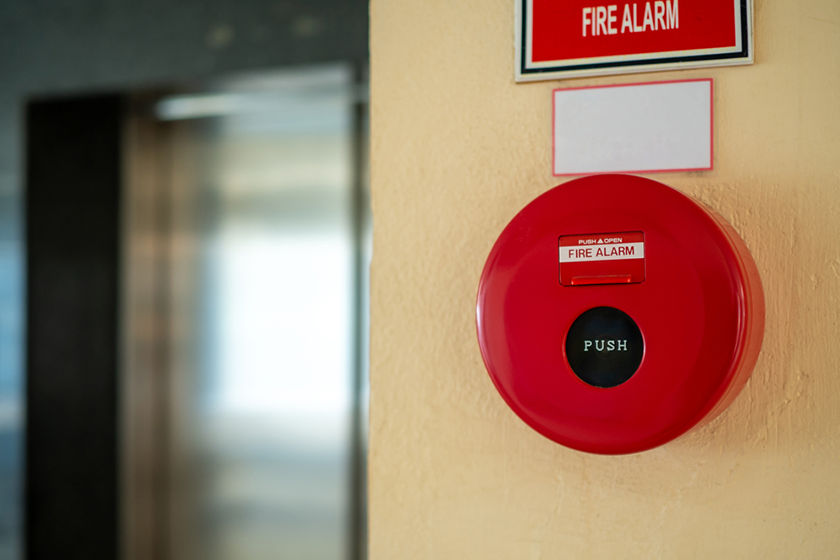Your Ultimate Industrial Fire Safety Checklist

An industrial fire safety checklist is imperative for protecting both property and personnel within industrial settings. This checklist is designed to provide a complete guide for organizations that need to boost their safety and prevent fire-related incidents in industrial facilities.
With industrial hazards often posing high risks, preparing a detailed checklist is necessary to guarantee regulatory compliance, protect assets, and safeguard lives.
Industrial Fire Safety Checklist
- Conduct Regular Fire Risk Assessments
Fire risk assessments are the basis of industrial fire safety. By identifying potential hazards, knowing fire risks, and putting strategies in place to reduce those risks, businesses can lessen the likelihood of fire incidents. These assessments should be performed routinely and whenever new equipment, materials, or processes are introduced.
Employing qualified professionals can increase the accuracy of these evaluations, so even subtle risks are identified and addressed. This practice not only minimizes risks but also supports compliance with fire safety regulations.
- Inspect and Maintain Fire Alarm Systems
A reliable fire alarm system is needed for rapid fire detection. Scheduling regular inspections and maintenance of fire alarm systems means that they’ll function optimally when needed.
Partnering with fire alarm service providers can assist with this process in identifying potential issues and performing necessary repairs.
Fire alarm systems should be checked for functionality, battery life, and signal transmission integrity. Immediate attention to any faults or malfunctions can prevent delays in alerting occupants during emergencies, which is critical for industrial safety.
- Provide Adequate Emergency Exits and Clear Signage
Accessible and well-marked emergency exits are imperative in industrial settings. Make sure that all emergency exits are unobstructed and clearly marked with visible signage. Emergency lighting should be functional, especially in areas prone to power outages.
Regular inspections of emergency exits and lights can prevent mishaps during an evacuation. Establishing clear escape routes and conducting regular drills reinforce employees’ knowledge of the correct evacuation paths, reducing panic and confusion if an emergency occurs.
- Install and Maintain Fire Suppression Systems
Fire suppression systems, like sprinklers, play a big part in containing fires before they escalate. Depending on the nature of the industrial environment, different types of fire suppression systems, including water, foam, or gas-based systems, may be necessary.
To make sure these systems perform as intended, conduct regular maintenance checks to assess their pressure, discharge mechanisms, and piping. A proactive approach to maintaining fire suppression systems can make a big difference in controlling fires at their onset, limiting damage, and providing for safety.
- Train Employees on Fire Safety Protocols
Employee training is central to any fire safety plan. Each team member should understand their responsibilities during an emergency and be familiar with fire safety protocols. Regular fire drills, guided by experienced emergency management and services providers, can prepare employees to respond confidently in real fire situations.
Training sessions should cover the use of fire extinguishers, identifying emergency exits, and knowing evacuation procedures. Familiarity with safety protocols can improve response times.
- Develop an Industrial Fire Safety Plan
A well-defined industrial fire safety plan encompasses all the elements of fire prevention, detection, suppression, and evacuation. This plan should address specific fire hazards in the industrial facility, emergency communication channels, and designated personnel roles.
Collaboration with industrial fire and safety services providers can provide additional expertise in putting together a safety plan. Regularly reviewing and updating this plan is important, especially as operational changes occur. A strong fire safety plan promotes a systematic approach to preventing and managing fire risks.
- Check Electrical Systems for Hazards
Electrical systems are a common source of fire hazards in industrial environments. Regular inspections of wiring, circuit breakers, and electrical equipment can prevent issues caused by faulty installations or aging systems.
Overloaded circuits, exposed wires, and poorly maintained equipment increase the risk of electrical fires. Routine electrical maintenance and adherence to industry safety standards are necessary in preventing fires.
Prompt repairs to address electrical hazards can also reduce fire risks, providing a safer industrial environment.
- Secure Hazardous Materials and Chemicals
Industries that handle hazardous materials or chemicals must take extra precautions. Storing flammable and combustible materials in designated, secure areas with appropriate ventilation can prevent accidental ignition. Fire-resistant containers and cabinets provide an added layer of protection.
Clear labeling and strict adherence to handling protocols are essential to avoid incidents. Employees should receive regular training on managing hazardous materials safely. Keeping updated safety data sheets (SDS) on-site further means that everyone will be informed of proper handling and emergency procedures.
- Establish an EST Partnership for Advanced Fire Safety Solutions
Setting up an EST partnership (Edwards Systems Technology) can improve an industrial facility’s fire safety approach. EST partnerships offer advanced fire safety technology, such as networked fire alarm systems, smoke detectors, and integrated safety solutions that suit complex industrial settings.
Leveraging EST’s innovative systems can simplify fire safety efforts, providing faster, more accurate alerts and allowing facilities to respond quickly to incidents. An EST partnership supports monitoring and control over fire safety measures, for compliance and protection.
- Verify Fire Extinguisher Accessibility and Condition
Accessible and functional fire extinguishers are needed in any industrial environment. Make sure that extinguishers are within reach in high-risk areas and are appropriate for the types of fires likely to occur in the facility. Each extinguisher should be inspected monthly, checking for proper pressure levels and expiration dates.
Employees should also know how to use them effectively. Fire extinguisher maintenance is essential since malfunctioning extinguishers are ineffective in controlling fire outbreaks, especially in industrial spaces where fire hazards are higher.
- Prioritize Clear Communication During Emergencies
Good communication can be lifesaving during a fire emergency. Installing intercom systems, PA systems, and mobile alerts can help quickly inform everyone in the facility of an emergency. Establishing designated communication leaders and using mobile technology can boost the clarity and reach of emergency messages.
Providing training on emergency communication procedures makes certain that all team members are well-prepared to relay information calmly and accurately in high-stress situations, thereby improving evacuation efficiency and safety.
- Coordinate with Emergency Management and Services Providers
Working with emergency management and services providers can bolster an industrial facility’s fire safety efforts. These providers offer specialized support, including emergency planning, risk assessments, and response training.
They also assist in refining evacuation plans, organizing fire drills, and establishing command centers during emergencies. Collaborating with emergency management experts ensures that the facility is prepared for potential fire incidents, minimizing risk and enhancing overall safety for personnel and property.
- Perform Routine Inspections and Record-Keeping
Routine inspections of fire safety equipment, exits, and emergency procedures are imperative for industrial fire safety. Complete records of inspections, maintenance, and any corrective actions taken provide documentation of the facility’s commitment to safety.
This record-keeping is necessary for regulatory compliance as authorities may require proof of regular safety checks. Staying organized with inspection logs and maintenance records also aids in identifying recurring issues, helping facilities address potential weaknesses proactively.
- Test Emergency Power Systems
In an industrial setting, maintaining emergency power systems is needed to support fire safety equipment, such as alarms, lighting, and communication systems. Backup generators and uninterruptible power supply (UPS) systems must be inspected and tested to confirm they’re operational during an emergency.
Regular testing of these systems, along with proper fuel storage and management, means that emergency power will be available when it’s needed most, providing uninterrupted protection during power outages.
- Review and Update Safety Measures Regularly
An industrial fire safety checklist should be a document that transforms with changes in the facility, industry standards, and fire safety technology. Regular reviews of the checklist allow for adjustments based on new risks or operational changes.
Using safety experts to re-evaluate and improve the checklist keeps it relevant and effective. Continual updates reflect a proactive commitment to fire safety so that both personnel and assets are protected as well as possible.
Choose Fire Safety Alarms for Your Industrial Fire Safety Needs
Partnering with Fire Safety Alarms means you’re working with an experienced team that values your safety above all else. With our extensive experience and knowledge of New York City’s fire safety regulations, we are equipped to provide unmatched fire protection solutions.
Our commitment to excellence and expertise allows us to deliver top-notch service in all aspects of fire safety, from alarm installation to emergency support.
Fire Safety Alarms has a range of services specialized to meet the needs of industrial facilities. From routine maintenance to advanced alarm systems, we handle every aspect of fire safety, so your operations are safeguarded 24/7.
Our team’s dedication to customer satisfaction is reflected in our swift response times and thorough service. Contact us now for reliable fire safety solutions that prioritize your peace of mind.
